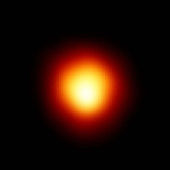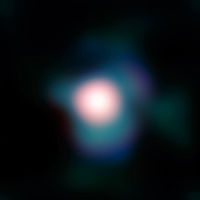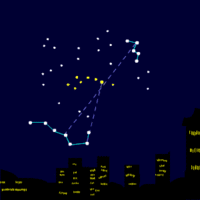- Portal:Star
-
The Star Portal
- Wikipedia portals:
- Culture
- Geography
- Health
- History
- Mathematics
- Natural sciences
- People
- Philosophy
- Religion
- Society
- Technology
Introduction
A star is a massive, luminous ball of plasma that is held together by gravity. The nearest star to Earth is the Sun, which is the source of most of the energy on Earth. Other stars are visible in the night sky, when they are not outshone by the Sun. Historically, the most prominent stars on the celestial sphere were grouped together into constellations, and the brightest stars gained proper names. Extensive catalogues of stars have been assembled by astronomers, which provide standardized star designations.For most of its life a star shines due to thermonuclear fusion in its core, releasing energy that traverses the star's interior and then radiates into outer space. Almost all elements heavier than hydrogen and helium were created by fusion processes in stars. Astronomers can determine the mass, age, chemical composition and many other properties of a star by observing its spectrum, luminosity and motion through space.
Selected star -
Photo credit: ESO/P. Kervella Betelgeuse is a semiregular variable star located approximately 640 light-years from the Earth. With an apparent magnitude ranging between 0.3 and 1.2, it is the ninth brightest star in the night sky. Although Betelgeuse has the Bayer designation Alpha Orionis (α Orionis / α Ori), it is most often the second brightest star in the constellation Orion behind α; Rigel (Beta Orionis) is usually brighter (Betelgeuse is a variable star and is on occasion brighter than Rigel). The star marks the upper right vertex of the Winter Triangle and center of the Winter Hexagon.
Betelgeuse is a red supergiant, and one of the largest and most luminous stars known. For comparison, if the star were at the center of our solar system its surface might extend out to between the orbits of Mars and Jupiter, wholly engulfing Mercury, Venus, the Earth and Mars. The angular diameter of Betelgeuse was first measured in 1920–1921 by Albert Abraham Michelson and Francis G. Pease using the 100 inch (2.5 m) John D. Hooker astronomical interferometer telescope atop Mount Wilson Observatory.
Astronomers believe Betelgeuse is only a few million years old, but has evolved rapidly because of its high mass. Due to its age, Betelgeuse may go supernova within the next millennium (because it is hundreds of light years away, it possibly may have done so already).
Read more... Selected article -
Photo credit: NASA/JPL-Caltech A supernova (plural supernovae) is a stellar explosion that is more energetic than a nova. Supernovae are extremely luminous and cause a burst of radiation that often briefly outshines an entire galaxy, before fading from view over several weeks or months. During this short interval a supernova can radiate as much energy as the Sun is expected to emit over its entire life span. The explosion expels much or all of a star's material at a velocity of up to 30,000 km/s (a tenth the speed of light), driving a shock wave into the surrounding interstellar medium. This shock wave sweeps up an expanding shell of gas and dust called a supernova remnant.
Several types of supernovae exist. Types I and II can be triggered in one of two ways, either turning off or suddenly turning on the production of energy through nuclear fusion. After the core of an aging massive star ceases to generate energy from nuclear fusion, it may undergo sudden gravitational collapse into a neutron star or black hole, releasing gravitational potential energy that heats and expels the star's outer layers.
Alternatively a white dwarf star may accumulate sufficient material from a stellar companion (either through accretion or via a merger) to raise its core temperature enough to ignite carbon fusion, at which point it undergoes runaway nuclear fusion, completely disrupting it. Stellar cores whose furnaces have permanently gone out collapse when their masses exceed the Chandrasekhar limit, while accreting white dwarfs ignite as they approach this limit (roughly 1.38 times the mass of the sun). White dwarfs are also subject to a different, much smaller type of thermonuclear explosion fueled by hydrogen on their surfaces called a nova. Solitary stars with a mass below approximately nine solar masses, such as the Sun, evolve into white dwarfs without ever becoming supernovae.
Read more... Selected biography -
Photo credit: Unknown artist, uploaded by User:ArtMechanic Johannes Kepler (IPA: [ˈkʰɛplɐ]) (December 27, 1571 – November 15, 1630) was a German mathematician, astronomer and astrologer, and key figure in the 17th century scientific revolution. He is best known for his eponymous laws of planetary motion, codified by later astronomers based on his works Astronomia nova, Harmonices Mundi, and Epitome of Copernican Astronomy. They also provided one of the foundations for Isaac Newton's theory of universal gravitation.
Kepler lived in an era when there was no clear distinction between astronomy and astrology, but there was a strong division between astronomy (a branch of mathematics within the liberal arts) and physics (a branch of natural philosophy). Kepler also incorporated religious arguments and reasoning into his work, motivated by the religious conviction that God had created the world according to an intelligible plan that is accessible through the natural light of reason. Kepler described his new astronomy as "celestial physics", as "an excursion into Aristotle's Metaphysics", and as "a supplement to Aristotle's On the Heavens", transforming the ancient tradition of physical cosmology by treating astronomy as part of a universal mathematical physics.
Johannes Kepler's first major astronomical work, Mysterium Cosmographicum (The Cosmographic Mystery), was the first published defense of the Copernican system. Kepler claimed to have had an epiphany on July 19, 1595, while teaching in Graz, demonstrating the periodic conjunction of Saturn and Jupiter in the zodiac; he realized that regular polygons bound one inscribed and one circumscribed circle at definite ratios, which, he reasoned, might be the geometrical basis of the universe.
Read more... Selected picture -
Photo credit: Hubble Space Telescope/NASA and ESA A planetary nebula is an emission nebula consisting of an expanding glowing shell of ionized gas and plasma ejected during the asymptotic giant branch phase of certain types of stars late in their life. This name originated with their first discovery in the 18th century because of their similarity in appearance to giant planets when viewed through small optical telescopes, and is otherwise unrelated to the planets of the solar system. They are a relatively short-lived phenomenon, lasting a few tens of thousands of years, compared to a typical stellar lifetime of several billion years.
At the end of the star's life, during the red giant phase, the outer layers of the star are expelled via pulsations and strong stellar winds. Without these opaque layers, the hot, luminous core emits ultraviolet radiation that ionizes the ejected outer layers of the star. This energized shell radiates as a planetary nebula.
Planetary nebulae play a crucial role in the chemical evolution of the galaxy, returning material to the interstellar medium that has been enriched in heavy elements and other products of nucleosynthesis (such as carbon, nitrogen, oxygen and calcium). In more distant galaxies, planetary nebulae may be the only objects that can be resolved to yield useful information about chemical abundances.
Read more... Did you know?
- ... that if the Voyager spacecraft travelled at its current speed in the direction of Proxima Centauri, the nearest star to the Sun, it would take around 80,000 years to arrive?
- ... that the largest known star, VY Canis Majoris, is nearly 1800 times bigger than our Sun?
- ... that our Galaxy is estimated to contain 200-400 billion stars, more than the number of humans that have ever lived?
- ... the brightest stellar event in recorded history was a supernova in the year 1006, which was bigger and brighter than Venus for three months.
- ... Sirius's name probably comes from a Greek word meaning “sparkling,” or “scorching”?
Categories
To display all subcategories click on the [+] [×] Protostars[×] Runaway starsTopics
Star Sun Galaxy Black hole Supernova More related topics... WikiProjects
Things to do

Here are some tasks you can do:- Article requests: See requested articles
- Cleanup: Instability strip, Strangelet, Neutronium
- Copyedit: Horizontal branch, Dark ES, Degenerate MA
- Expand: See star stubs ..Lodestar, Preon star, Gravastar, Preon, Black star
- Stubs: See star stubs ..Stellar dynamics
- Update: Radiation zone, Quark star, Sub-brown dwarf
- Wikify: Starspot, Stellar black hole, Chromosphere
- Other: Circumpolar star, Luminous blue variable
Related portals
Wikimedia
Purge server cache Categories:- Stars
- Astronomy portals
Wikimedia Foundation. 2010.













